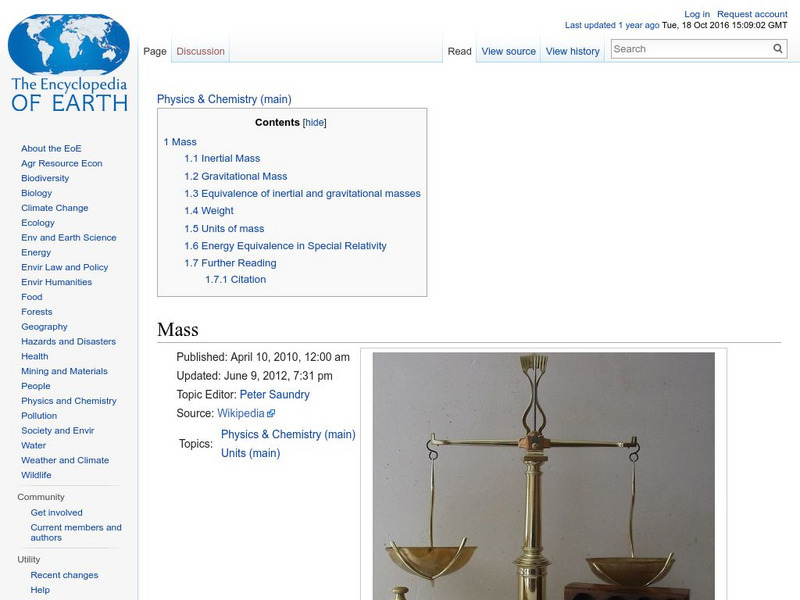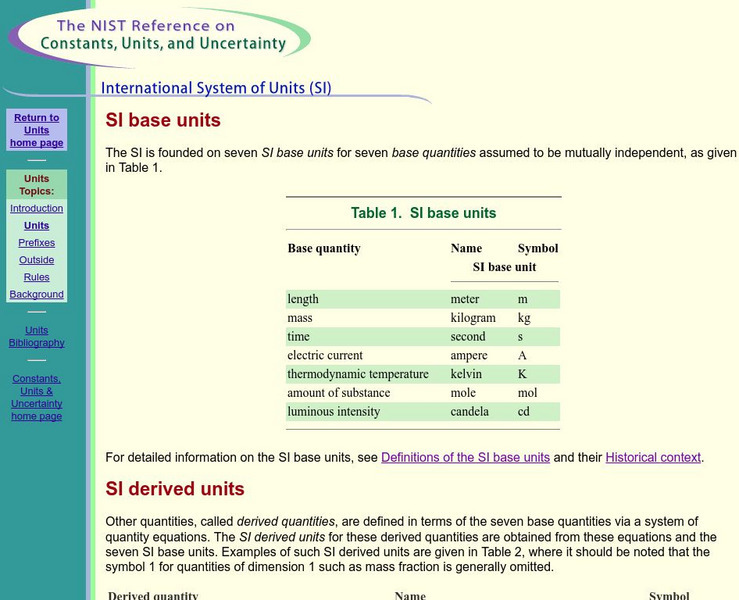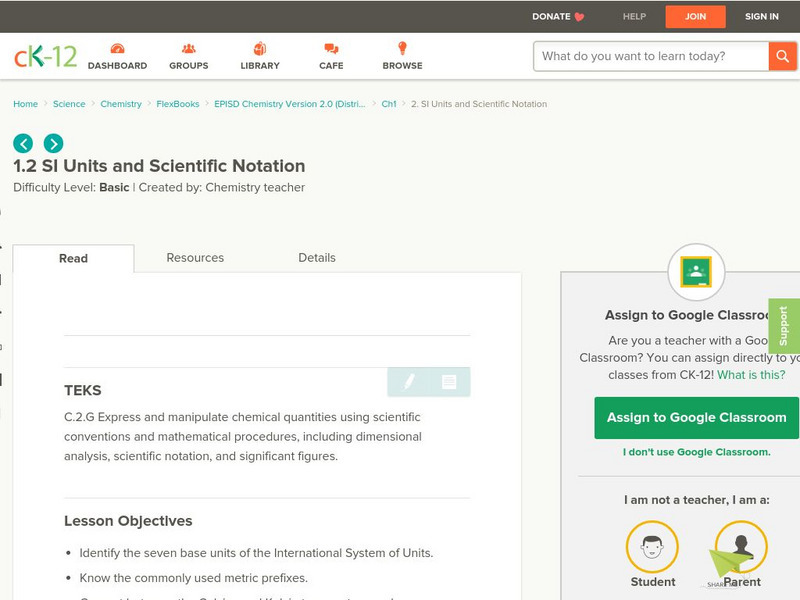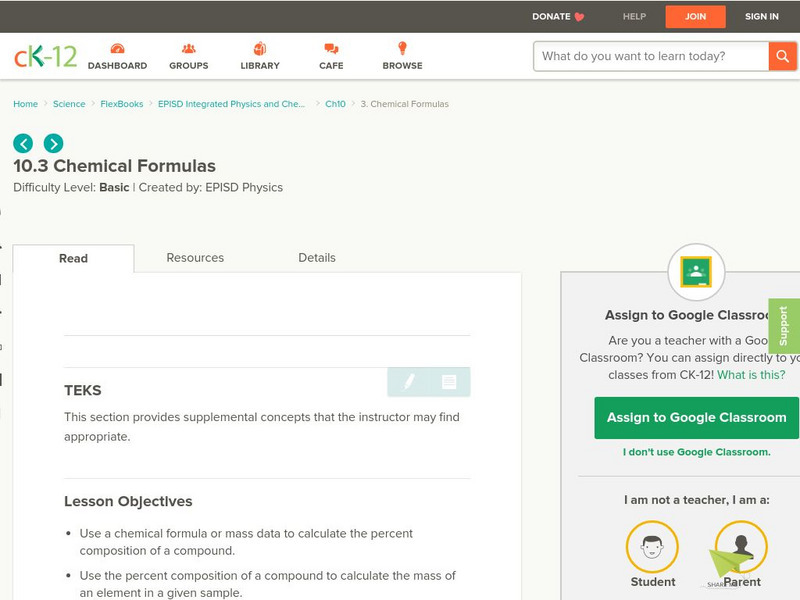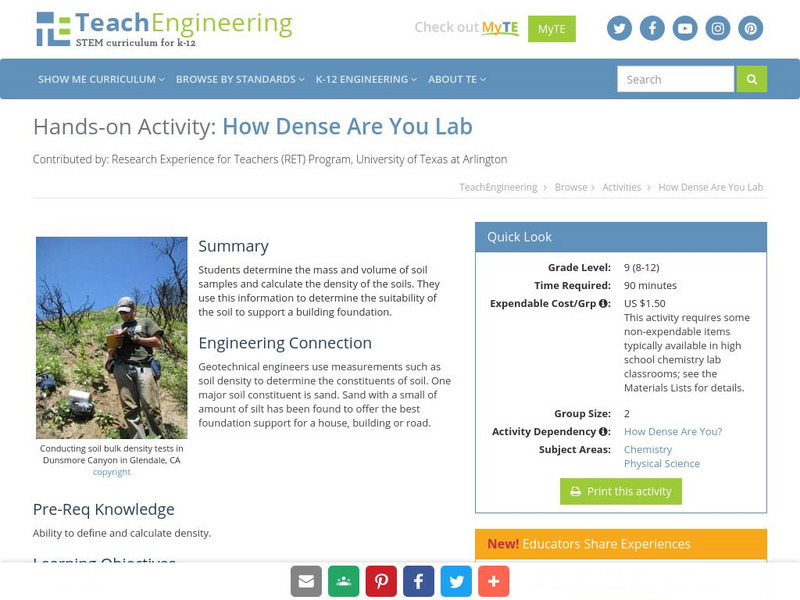BioEd Online
Bio Ed Online: Introduction to Force and Motion
How is the motion of an object affected by forces that act on that object? Can you predict how the motion of an object will be affected by balanced and unbalanced forces? Is there a relationship between force, mass, and acceleration? In...
Encyclopedia of Earth
Encyclopedia of Earth: Physics & Chemistry: Mass
Defines inertial and gravitational mass, their scientific history, formulas used in their calculation, the definition of weight, units used for mass, and mass as perceived in the theory of special relativity.
PBS
Pbs Mathline: Mystery Liquids Lesson Plan [Pdf]
Students gather data from two mystery liquids to explore linear functions. Printable lesson.
University of Colorado
University of Colorado: Ph Et Interactive Simulations: Density
An interactive simulation that teaches about density, mass, and volume through explorations of mass and volume with different objects. This simulation can either be downloaded or played online and includes handouts, lesson plans, and...
University of Colorado
University of Colorado: Ph Et Interactive Simulations: Lunar Lander
An interactive simulation that teaches about the lunar landing, the moon, and mass by observing how changes in mass and thrust affect fuel consumption while trying to avoid a boulder field and put a lunar lander on the moon. This...
PBS
Pbs Teachers: Supersonic Dream
Examine how fuel use affects the mass of different planes during flight. This activity teaches students how to determine the per person fuel cost of a transatlantic flight for seven airplanes, and display the results on a bar graph....
Other
Lancaster University: Particle Physics Package
A collection of experiments, projects, and articles that will help students understand particle collision and mass, kinetic energy, magnetic field, the Large Hadron Collider, and detection of the Higgs particle.
National Institute of Standards and Technology (NIST)
International System of Units: Si Base Units
This is the definitive source for information on SI base units, derived units, squares, cubes, luminosity, field strength and flux density.
McGraw Hill
Glencoe: Self Check Quizzes 1 Mass and Capacity Metric System
Use Glencoe's randomly generated self-checking quiz to test your knowledge of mass and capacity in the Metric System. Each question has a "Hint" link to help. Choose the correct answer for each problem. At the bottom of the page click...
Sophia Learning
Sophia: Newton's Second Law: Lesson 3
This lesson introduces Newton's Second Law and explains that force is equal to mass times acceleration. It is 3 of 3 in the series titled "Newton's Second Law."
CK-12 Foundation
Ck 12: The International System of Units
[Free Registration/Login may be required to access all resource tools.] In this online tutorial students will begin to identify the seven base units of the International System of Units. They will understand the commonly used metric...
CK-12 Foundation
Ck 12: Chemical Formulas
[Free Registration/Login may be required to access all resource tools.] Students will use a chemical formula or mass data to calculate the percent composition of a compound, and then calculate the empirical or molecular formula for a...
Georgia Department of Education
Ga Virtual Learning: Ap Physics 1: Newton's Laws of Motion
Newton's three laws are deceptively simple, but they are the underpinning of all of physics and govern the mechanics all of your actions in everyday life. Take an in-depth look at these laws in this learning module.
Khan Academy
Khan Academy: Dalton's Atomic Theory
Article explores the key points of Dalton's atomic theory and the laws of conservation of mass and constant composition. Which points do we still use today?
Texas Education Agency
Texas Gateway: Properties: Extensive and Intensive
Find out about physical and chemical properties of matter, and then compare extensive and intensive property characteristics.
Other
Memorial Sloan Kettering Cancer Center: Cancer
General information on what cancer is, types of cancer, treatment and prevention.
OpenStax
Open Stax: Newton's First Law of Motion: Inertia
In the following interactive students will begin to define mass and inertia and understand Newton's first law of motion.
OpenStax
Open Stax: Physical Quantities and Units
Giving numerical values for physical quantities and equations for physical principles allows us to understand nature much more deeply than does qualitative description alone. To comprehend these vast ranges, we must also have accepted...
American Chemical Society
American Chemical Society: Hompage
ChemCenter, available from the American Chemical Society, provides chemistry news, reference sources and other public services.
TeachEngineering
Teach Engineering: Mint Mobiles
Students design, build and test model race cars made from simple materials (lifesaver-shaped candies, plastic drinking straws, Popsicle sticks, index cards, tape) as a way to explore independent, dependent and control variables. They...
TeachEngineering
Teach Engineering: Action Reaction! Rocket
Students construct a rocket from a balloon propelled along a guide string. They use this model to learn about Newton's three laws of motion, examining the effect of different forces on the motion of the rocket.
TeachEngineering
Teach Engineering: Does Your Chewing Gum Lose Its Flavor?
In the first part of the activity, each student chews a piece of gum until it loses its flavor, and then leaves the gum to dry for several days before weighing it to determine the amount of mass lost. This mass corresponds to the amount...
TeachEngineering
Teach Engineering: How Dense Are You Lab
Students determine the mass and volume of soil samples and calculate the density of the soils. They use this information to determine the suitability of the soil to support a building foundation.
TeachEngineering
Teach Engineering: Density Column Lab Part 1
In this first part of a two-part lab activity, students use triple balance beams and graduated cylinders to take measurements and calculate the densities of several common, irregularly shaped objects with the purpose to resolve confusion...

